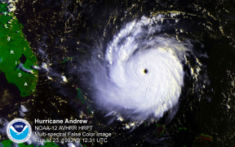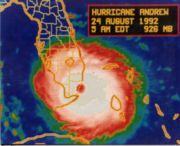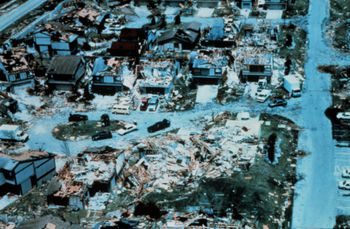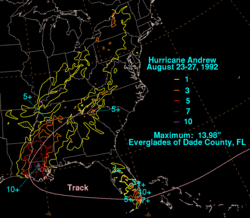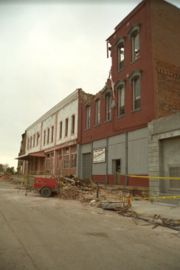Hurricane Andrew
2007 Schools Wikipedia Selection. Related subjects: Natural Disasters
-
This article is about the 1992 hurricane; there was also a Tropical Storm Andrew during the 1986 Atlantic hurricane season.
| Category 5 hurricane ( SSHS) | ||
|---|---|---|
|
Hurricane Andrew approaching the Bahamas and Florida at peak intensity |
||
| Formed | August 16, 1992 | |
| Dissipated | August 28, 1992 | |
| Highest winds |
|
|
| Lowest pressure | 922 mbar ( hPa) | |
| Damage | $26 billion (1992 USD) $45 billion (2005 USD) | |
| Fatalities | 65 (26 direct, 39 indirect) | |
| Areas affected |
Bahamas; South Florida, Louisiana, and other areas of the Southern United States | |
| Part of the 1992 Atlantic hurricane season |
||
Hurricane Andrew was the second most destructive hurricane in U.S. history, and the final of three Category 5 hurricanes to make landfall in the United States in the 20th century. Striking as the first named storm of the 1992 Atlantic hurricane season in August 1992, Andrew caused damage in the northwestern Bahamas, southern Florida south of Miami, and south-central Louisiana. Andrew's damage cost totaled $26 billion in 1992 ($45 billion in 2005 US dollars), mostly in south Florida. The storm caused 65 deaths. With a central pressure ranking as the fourth lowest in U.S. landfall records, Andrew remained the most devastating natural disaster in U.S. history until it was surpassed by Hurricane Katrina in the 2005 season.
Storm history
Andrew started modestly as a tropical wave that emerged from the west coast of Africa on August 14, and passed south of the Cape Verde islands. The wave spawned a tropical depression on August 16, which became Tropical Storm Andrew the next day.
Further development was slow, as the west-northwestward moving Andrew encountered an unfavorable upper-level trough. Indeed, the storm almost dissipated on August 20 due to vertical wind shear. By August 21, Andrew was midway between Bermuda and Puerto Rico and then began turning westward into a more favorable environment. Rapid strengthening occurred, with Andrew reaching hurricane strength (sustained winds greater than 74 mph) on the 22nd and Category 5 status on the Saffir-Simpson Hurricane Scale on the 23rd, peaking with 175 mph (280 km/h) winds and a minimum pressure of 922 mbar ( hPa). The storm was extremely small, however, with gale-force (35 mph, 55 km/h) winds extending outwards only 90 miles (150 km) from the centre.
Andrew made landfall twice while moving through the Bahamas, crossing Eleuthera with 160 mph (260 km/h) winds and passing through the Berry Islands at Great Harbour Cay with sustained winds of 150 mph (240 km/h). The storm weakened after its second landfall, maintaining strong winds but with the pressure rising to 937 mbar. While crossing the Gulf Stream, however, Andrew quickly regained its strength, and briefly regained Category 5 status as it made landfall over south Florida on August 24 with 165 mph (265 km/h) winds and pressure of 922 mbar (hPa).
The hurricane continued westward into the Gulf of Mexico as a Category 4 hurricane, where it gradually turned northward. This motion brought Andrew to the central Louisiana coast (near Morgan City) on August 26 as a Category 3 hurricane with sustained winds near 115mph. Andrew then turned northeastward, eventually merging with a frontal system over the mid-Atlantic states on August 28.
Statistics
Reports from private barometers helped establish that Andrew's central pressure at landfall in Homestead, Florida, was 27.23 inches (922 hPa), which at the time made it the third most intense hurricane on record to hit the United States (it has since fallen to fourth, as of 2005 Katrina).
| Most intense landfalling U.S. hurricanes Intensity is measured solely by central pressure |
|||
|---|---|---|---|
| Rank | Hurricane | Season | Landfall pressure |
| 1 | "Labor Day" | 1935 | 892 mbar ( hPa) |
| 2 | Camille | 1969 | 909 mbar (hPa) |
| 3 | Katrina | 2005 | 920 mbar (hPa) |
| 4 | Andrew | 1992 | 922 mbar (hPa) |
| 5 | "Indianola" | 1886 | 925 mbar (hPa) |
| 6 | "Florida Keys" | 1919 | 927 mbar (hPa) |
| 7 | "Okeechobee" | 1928 | 929 mbar (hPa) |
| 8 | Donna | 1960 | 930 mbar (hPa) |
| 9 | " New Orleans" | 1915 | 931 mbar (hPa) |
| 10 | Carla | 1961 | 931 mbar (hPa) |
| Source: U.S. National Hurricane Centre | |||
Andrew's peak winds in south Florida were not directly measured due to destruction of the measuring instruments. An automated station at Fowey Rocks reported 142 mph (228 km/h) sustained winds with gusts to 200 mph (321 km/h) (measured 144 ft (43.9 m) above the ground), and higher values may have occurred after the station was damaged and stopped reporting. A meteorologist living about a mile from the shoreline recorded a gust of 212 mph (341 km/h) before his instruments were destroyed.
The National Hurricane Centre had a peak gust of 164 mph (272 km/h) (measured 130 ft (39.6 m) above the ground) just before the hurricane crippled its measuring devices, while a 177 mph (285 km/h) gust was measured at a private home. In 2002, as part of an ongoing review of historical hurricane records, National Hurricane Centre experts concluded that Andrew briefly had sustained winds of 165 mph (265 km/h) during and before landfall (Andrew had originally been classified as a Category 4 storm at landfall) . High gusts occurred in other locations throughout the state of Florida with 163 mph at Turkey Point power plant, and 160 mph at Turkey Point nuclear power plant, and 115 mph at Miami International Airport, with lower gusts throughout the state.
Additionally, Berwick, Louisiana, reported 96 mph (154 km/h) sustained winds with gusts to 120 mph (193 km/h). The highest gust of 173 mph occurred in St. Mary Parish, Louisiana.
Records
Andrew was only the third Category 5 hurricane to hit the United States, the previous ones being Hurricane Camille (which hit Mississippi and Louisiana in August 1969) and the Labor Day Hurricane of 1935 (which struck the Florida Keys in September 1935). No Category 5 hurricane in the Atlantic has struck the United States(or anywhere else) at that intensity since.
Preparations
10 to 14 ft storm surge, with locally 18 ft, was predicted prior to impact in the Bahamas. 5 to 8 inches of rain was also predicted. Evacuations were also ordered by emergency management officials, and residents throughout the region of Bahamas and Florida were warned to take precautions to protect life and property at 5 PM local time. By 11 PM local time, residents were warned that precautions to protect life and property should have been completed. 7 to 10 foot storm surge was predicted for Eastern Florida, and the Florida Keys and 7 to 11 foot storm surge was predicted for Western Florida was predicted after the storm exitted Florida. Some isolated tornadoes were also predicted for South and Central Florida for August 23 and August 24. The National Guard was deployed to Florida to prevent looting. At least 1500 troops were deployed to the area.
Sandbag walls were created in the South Bell Telephone Building in New Orleans. Sandbag walls were also created in the French Quarter section of New Orleans. Floodgates were also closed throughout New Orleans Levees. Sandbags for the public ran out, due to the protection of major areas. Planes headed to and from New Orleans were canceled.
Impact
Florida
As with most high-intensity storms (Categories 4 and 5), the worst damage from Andrew is thought to have occurred not from straight-line winds but from vortices, or "miniwhirls" (something like embedded tornadoes). This was the conclusion of Tetsuya Theodore Fujita, a University of Chicago meteorologist who devised the Fujita scale for measuring the strength of tornadoes, after he surveyed Andrew's destruction in the Homestead area. There were thousands of these vortexes in Andrew; many of them could be traced for several miles, as they usually destroyed every building in their paths.
Looting was also attempted in Florida after the storm left. At least 100 people attempted to do so in a shopping mall south of Miami. However 600 National Guard troops in the region stopped their attempted theft.
Andrew produced a 17 ft (5.2 m) storm surge near the landfall point in Florida, while storm tides of at least eight ft (2.4 m) inundated portions of the Louisiana coast. Andrew also produced a killer tornado in southeastern Louisiana. The F3 tornado hit LaPlace and stayed on ground until Reserve, St. John the Baptist Parish. The tornado caused two deaths.
| Costliest U.S. Atlantic hurricanes Cost refers to total estimated property damage. |
|||||||
|---|---|---|---|---|---|---|---|
| Rank | Hurricane | Season | Cost (2005 USD) | ||||
| 1 | Katrina | 2005 | $81.2 billion | ||||
| 2 | Andrew | 1992 | $44.9 billion | ||||
| 3 | Wilma | 2005 | $20.6 billion | ||||
| 4 | Charley | 2004 | $15.4 billion | ||||
| 5 | Ivan | 2004 | $14.6 billion | ||||
| Main article: List of notable Atlantic hurricanes | |||||||
Andrew was responsible for 23 deaths in the United States and three more in the Bahamas. The hurricane caused $26.5 billion ( 1992 USD) in damage in the United States, of which $1 billion occurred in Louisiana and the rest in south Florida. Unlike most hurricanes, the vast majority of the damage in Florida was due to the winds. The agricultural loss in Florida was $1.04 billion alone. Damage in the Bahamas was estimated at $250 million.
In Dade County 90% of homes had major roof damage. 117,000 were destroyed or had major damage.
The Turkey Point Nuclear Generating Station was hit directly by Andrew. Over $90 million of damage was done, largely to a water tank and to a smokestack of one of the fossil-fueled units on-site, but the containment buildings were undamaged. The nuclear plant was built to withstand winds of up to 235 mph.
Massive damage caused by Andrew at Homestead Air Force Base, very near the point of landfall on the South Florida coast, led to the closing of the base as a full active-duty base. It was later partly rebuilt and operates today as a U.S. Air Reserve base. The aircraft and squadron were relocated to Aviano AFB in Italy.
Power lines bringing electric power to the Florida Keys were destroyed, leaving residents without power. However water was maintained, although it had to be boiled.
There was also moderate damage to the coral reef areas offshore of Florida down to depths of 75 feet.
Louisiana
About 152,000 electricity customers lost their power due to the impact of Andrew. Four people were also killed, as a result of Andrew.
Damage was done to soy bean, corn, and sugar cane crops. The damage estimated done to the sugar cane was $200 million.
A Coast Guard helicopter had to rescue 4 people and 2 dogs from a disabled 65 foot fishing boat, 50 miles south of Houma.
Aftermath
Florida
Andrew's catastrophic damage spawned many rumors, including claims that hundreds or even thousands of migrant farm workers in south Dade County (now Miami-Dade County) were killed and their deaths were not reported in official accounts. An investigation by the Miami Herald found no basis for such rumors. These rumors were probably based on the 1928 Okeechobee Hurricane, when the deaths of migrant workers initially went uncounted, and were still debated at the time of Andrew.
The slow response of federal aid to storm victims in southern Florida led Dade County emergency management director Kate Hale to famously exclaim at a nationally televised news conference, "Where in the hell is the cavalry on this one? They keep saying we're going to get supplies. For God's sake, where are they?" Almost immediately, President George H. W. Bush promised, "Help is on the way," and mobile kitchens and tents began pouring in.
Insurance claims in the wake of the extreme damage left by Andrew led to the bankruptcy and closure of 11 insurance agencies and drained an excessive amount of equity from 30 more. Nearly one million residences were no longer eligible for coverage by any insurance agency. This led the Florida Legislature to create new agencies (the Joint Underwriting Association, the Florida Windstorm Underwriting Association and the Florida Hurricane Catastrophe Fund) to restore adequate insurance coverage.
Homeowners and officials criticized developers and contractors for inadequate building practices and poor building codes. An inquiry after the storm concluded that there were probably construction flaws in some buildings, and that the state of Florida did enforce some strict building codes since 1986, but they were either overlooked or ignored. However, the evidence was not sufficient enough to issue criminal charges for neglect.
The effects of Hurricane Andrew on Florida wetlands were considerable. In the Florida Everglades, 25% (700,000 acres) of the trees in the everglades were knocked down by the storm. However, new trees and vegetation grew 20 days after the storms passing. Damage to marine life was moderate as the storm increased the turbidity and lowered the oxygen level in the water, threatening many fish and other marine wildlife. In addition, the storm killed 182 million fish in the basin, causing $160 million dollars (1992 USD) in lost value. In the decade after the storm, Hurricane Andrew may have contributed to the massive and sudden housing boom in Broward County, Florida. Located just north of Miami-Dade County, residents who had lost their homes migrated to western sections of the county that were just starting to be developed. The result was record growth in places like Miramar, Pembroke Pines and Weston. Two of these three cities have been listed in the top ten Fastest Growing Cities Within The United States within the past fourteen years .
Louisiana
In Louisiana, the hurricane knocked down 80 percent of the trees in part of the Atchafalaya River Basin near the coast. Offshore, the storm killed 9.4 million fish, causing $7.8 million dollars (1992 USD) in lost value, and damaged large area of marshland along the Louisiana coast.
About 6,200 people had to be housed in 36 seperate shelters, according to the American Red Cross. The Salvation Army sent in 37 mobile food storage faculities, that served 40,000 meals, to help those who could get little or no food.
Federal aid, from the Pentagon, sent in four 750,000 kilowatt generators, 2,500 cots, and 30,000 MRE's, or prepackaged meals, to Louisiana. About 1,279 National Guard were deployed to Louisiana, to do various duties, from cooking to patrolling.
Sheriefs along the coast of Louisiana imposed a curfew from 6 p.m. to 6 a.m. local time. Alcohol sales were also banned immediately after the storm.
Retirement
The name Andrew was retired in the spring of 1993 and will never again be used for an Atlantic hurricane. It was replaced with Alex in the 1998 season.
